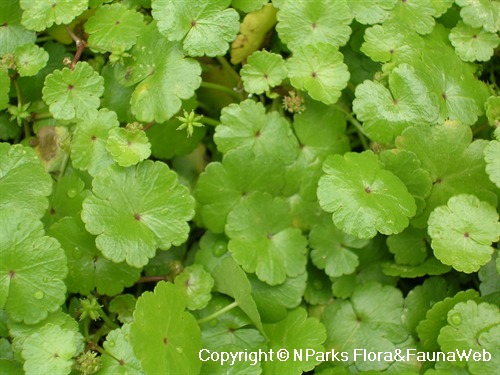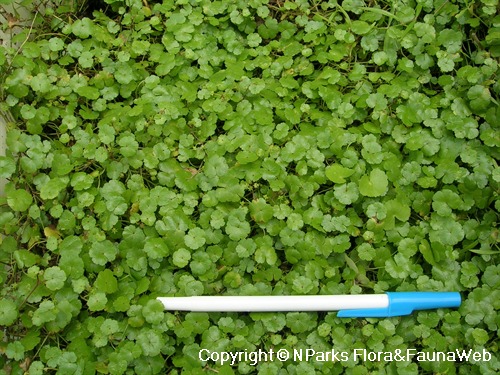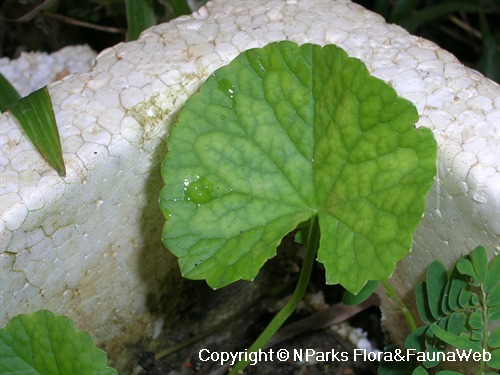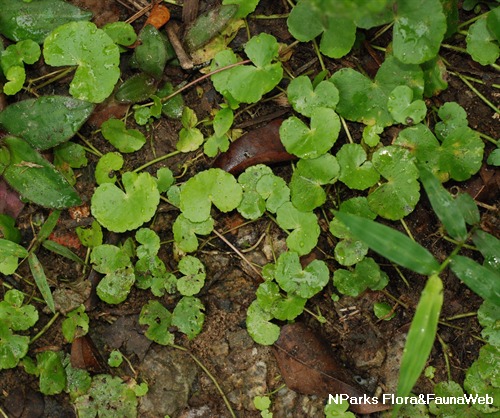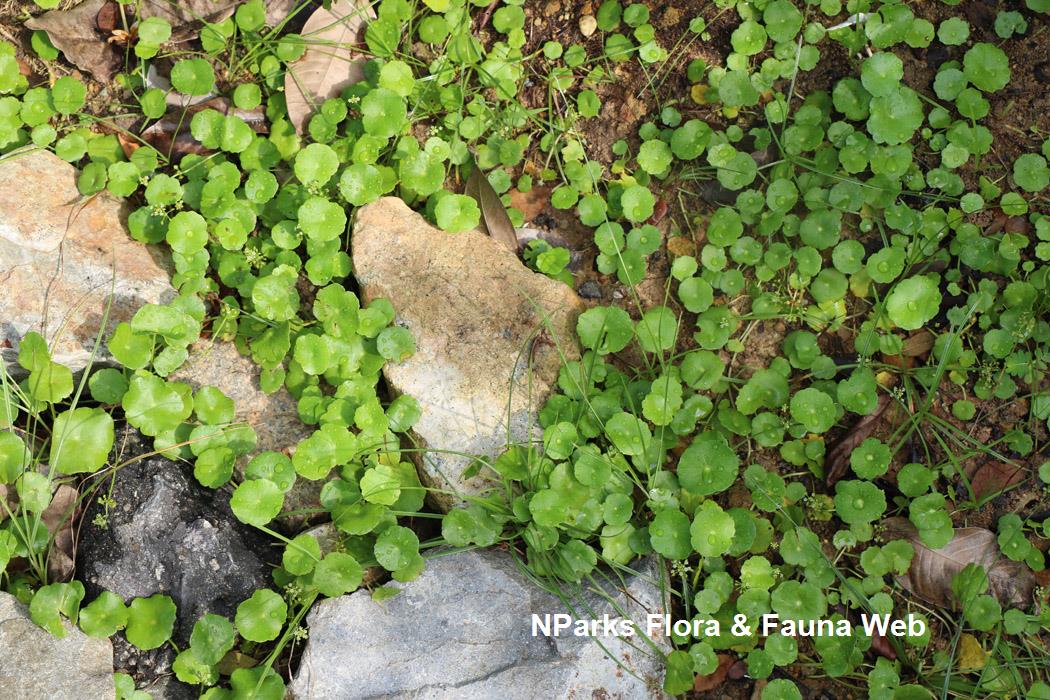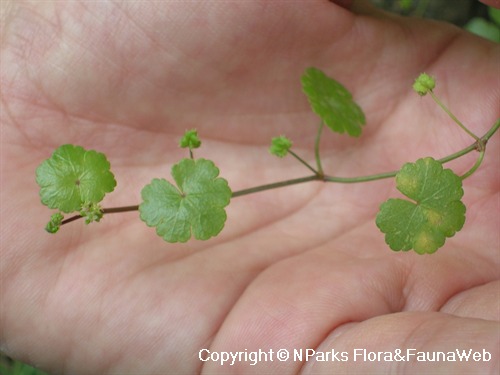
Back
Hydrocotyle sibthorpioides Lam.
| Family Name: | Apiaceae (Umbelliferae) |
| Synonyms: | Hydrocotyle rotundifolia Roxb. |
| Common Name: | Lawn Marshpennywort, Lawn Pennywort, Crystal Confetti Pennywort, Kara-kara, Pegaga Embun, Tikim, Ulam Gunung, 天胡荽 |
Name
Classifications and Characteristics
| Plant Division | Angiosperms (Flowering Seed Plants) (Dicotyledon) |
|---|---|
| Plant Growth Form | Aquatic & Hydrophyte, Herbaceous Plant, Creeper |
| Lifespan (in Singapore) | Perennial |
| Mode of Nutrition | Autotrophic |
| Maximum Height | 2.5 cm to 5 cm |
Biogeography
| Native Distribution | Bhutan, India, China, Japan, Korea, Nepal, Vietnam, Thailand, Peninsular Malaysia, Singapore, Indonesia, and the Philippines |
|---|---|
| Native Habitat | Terrestrial (Primary Rainforest, Mountain, Agricultural Land, Secondary Rainforest, Riverine, Grassland / Savannah/ Scrubland, Disturbed Area / Open Ground) |
| Preferred Climate Zone | Tropical |
| Local Conservation Status | Native to Singapore (Least Concern (LC)) |
Description and Ethnobotany
| Growth Form | It is a slender perennial herb with a creeping growth habit. Forms a dense mat of leaves. |
|---|---|
| Foliage | Its stalked leaves have membranous leaf blades that are kidney-shaped-rounded to 5-angular in outline, shining light green, variable in hairiness of the leaves, and 0.5–1.5 by 0.8–2.5 cm. |
| Stems | Its stems are thin, round and cream-coloured. |
| Flowers | Each flowering shoot has 5–8 flowers. Its flowers have greenish-white petals that are egg-shaped, about 1.2 mm long, and have yellow glands. |
| Fruit | Its fruits are small, broadly round, greenish-yellow when young, yellow to brown and covered with purplish stains when mature, 1–1.25 by 0.75 mm, and have very prominent ribs. |
| Habitat | It grows in forests, slopes, valleys, grassy places and stream banks up to 3000 m altitude. |
| Cultivation | This species can be grown submerged underwater, floating on water or potted in moist soil. Propagate by stem cutting including at least 1 node or part of the stem where the leaf is connected. |
| Etymology | Greek Hydrocotyle, water cup, the reference to which is unknown; Latin sibthorpia, commemorating Professor Humpfrey Sibthorp, of Oxford, and his son John, English botanist |
| Ethnobotanical Uses | Food (Fruit or Vegetable): It is eaten as a vegetable. Medicinal: It is used to treat coughs in folk medicine. |
Landscaping Features
| Landscaping | It is suitable as a groundcover for waterlogged areas in parks, along the edges of waterbodies, or in aquariums for its ornamental round leaves. |
|---|---|
| Desirable Plant Features | Ornamental Foliage |
| Landscape Uses | Parks & Gardens, Small Gardens, Riverine, Pond / Lake / River, Marsh / Bog, Groundcover, Terrarium, Aquarium / Aquascape |
Fauna, Pollination and Dispersal
| Pollination Method(s) | Biotic (Fauna) |
|---|
Plant Care and Propagation
| Light Preference | Semi-Shade, Full Sun |
|---|---|
| Water Preference | Moderate Water, Lots of Water |
| Plant Growth Rate | Fast |
| Rootzone Tolerance | Moist Soils, Waterlogged Soils (Drains Site, Does not Drain Site), Fertile Loamy Soils |
| Transplanting Tolerance | Good |
| Maintenance Requirements | Low |
| Propagation Method | Seed, Stem Cutting, Division |
Foliar
| Foliage Retention | Evergreen |
|---|---|
| Mature Foliage Colour(s) | Green, Green - Light Green |
| Mature Foliage Texture(s) | Smooth, Glossy / Shiny |
| Foliar Type | Simple / Unifoliate |
| Foliar Attachment to Stem | Petiolate |
| Foliar Shape(s) | Non-Palm Foliage (Orbicular / Round) |
| Foliar Venation | Palmate |
Floral (Angiosperm)
| Flower & Plant Sexuality | Bisexual Flowers |
| Flower Colour(s) | Green - Light Green, White |
|---|---|
| Flower Grouping | Cluster / Inflorescence |
| Flower Location | Axillary |
Fruit, Seed and Spore
| Mature Fruit Colour(s) | Brown, Yellow / Golden |
|---|---|
| Fruit Classification | Simple Fruit |
Image Repository
Others
| Master ID | 822 |
|---|---|
| Species ID | 2117 |
| Flora Disclaimer | The information in this website has been compiled from reliable sources, such as reference works on medicinal plants. It is not a substitute for medical advice or treatment and NParks does not purport to provide any medical advice. Readers should always consult his/her physician before using or consuming a plant for medicinal purposes. |

